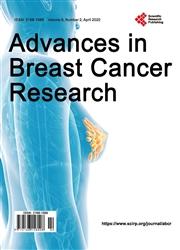Histochemical Patterns of Collagenic Fibers in the Benign and Malignant Breast Lesions
引用次数: 1
Abstract
Cancer is one of the leading causes of death worldwide and breast cancer is the most commonly diagnosed cancer among women. An increased incidence of different types of breast cancer has been reported. This study was designed to evaluate the different types of breast cancer and its possible risk of neoplasmic transformation to an advanced malignant stage from a benign tumor. The histochemical patterns of collagen fibers in the benign and malignant breast lesions were evaluated. From the 50 tissue samples, 25 were malignant breast lesions and 25 were benign breast tumor. Hematoxylin and Eosin (HE), Van Gieson staining were performed to detect a benign and malignant tumor as well as collagen fibers. We found that significant cases after age of 35 were associated with ductal carcinoma while most of the cases within the age of 25 years were associated with fibrocystic changes. The intensity of collagen fiber was higher to Ductal Carcinoma while negative and less intense for Fibroblastic changes. Furthermore, a consistent association of other lesions, such as Lobular Carcinoma, Fibroadenoma, Papilloma and Fat necrosis and noticeable staining for collagen was observed for the different lesion. Our study suggested that women with age of 25 with benign lesion of fibrocystic change and ductal carcinoma are highly susceptible to develop advanced malignant tumor with age. Therefore, quantitative measurement of collagen fiber and regular follow-up are recommended to avoid the possible risk of developing advanced malignant lesions.乳腺良恶性病变中胶原纤维的组织化学特征
癌症是全世界死亡的主要原因之一,乳腺癌是妇女中最常见的癌症。据报道,不同类型乳腺癌的发病率有所增加。本研究旨在评估不同类型的乳腺癌及其从良性肿瘤转变为晚期恶性肿瘤的可能风险。对乳腺良恶性病变中胶原纤维的组织化学形态进行了评价。50例组织标本中,乳腺恶性病变25例,乳腺良性肿瘤25例。苏木精和伊红(HE)染色,Van Gieson染色检测良、恶性肿瘤及胶原纤维。我们发现35岁以后的病例与导管癌相关,而25岁以内的大多数病例与纤维囊性变相关。导管癌的胶原纤维强度较高,成纤维细胞的胶原纤维强度较低,呈阴性。此外,其他病变,如小叶癌、纤维腺瘤、乳头状瘤和脂肪坏死,以及明显的胶原染色,在不同的病变中也观察到一致的相关性。我们的研究表明,25岁的女性纤维囊性变和导管癌的良性病变随着年龄的增长极易发展为晚期恶性肿瘤。因此,建议定量测量胶原纤维并定期随访,以避免可能发展为晚期恶性病变的风险。
本文章由计算机程序翻译,如有差异,请以英文原文为准。
求助全文
约1分钟内获得全文
求助全文

 求助内容:
求助内容: 应助结果提醒方式:
应助结果提醒方式:


